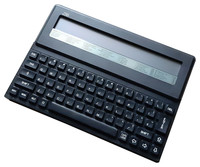Cambridge Z88
| Home > Browse Our Collection > Computers > Cambridge Computer > Cambridge Z88 |
|
The Cambridge Computer Z88 was an A4-size, lightweight, portable Z80-based computer with a built-in combined word processing/spreadsheet/database application called Pipedream, along with several other apps/utilities, such as a Z80-version of BBC BASIC. The machine was conceived by Sir Clive Sinclair and released by his company Cambridge Computer in 1987 (Sir Clive would have marketed the computer as the Sinclair Z88, but sold the Sinclair name and IP to Amstrad in 1986).
The Z88 is a portable computer based on a low-power CMOS version of the popular Z80 microprocessor. It comes with 32 KB of internal pseudo-static RAM and 128 KiB of ROM containing the Operating System (called OZ), but can be expanded up to 3.5 MB of RAM, of which the contents are preserved thanks to the batteries. An integrated capacitor prevents the Z88 from losing its data for a limited amount of time while changing the batteries.
Despite the lightness of the Z88—it weighs 0.9 kg—its construction is surprisingly robust, including its membrane/chiclet keyboard which is both comfortable and almost inaudible (an optional electronic "click" can be turned on if it proves too quiet for the user's taste). Powered by four AA batteries (giving up to 20 hours of use), the computer has three memory slots; each of which can be used for RAM expansion, removable mass storage, and proprietary program use. Since the slots use RAM, EPROM and ROM for their data transfer, the transfer speeds are usually very high. Although RAM cards of up to 1 MB capacity were available, they were expensive. Most users used one or two 128 KB cards. There were useful peripherals brought to market by Cambridge, including a PC Link, so the Z88 could be connected to the home PC to back up and store data. Also the ROM cards would store data, such as documents, but these files could not be erased by the computer, so there was an EPROM eraser that would use UV light to rid the card of data after back up. There was also a link pack to attach the Z88 to a BBC Micro. Though the SuperTwist LCD display has only eight lines, it is clear and surprisingly effective. In Pipedream, a miniature view of a whole page appears to the right of the display, giving a good feel for the overall layout, and compensating for the inevitable "letterbox" effect. Our model is in excellent condition with the original box and manual Manufacturer: Cambridge Comment on This Page Other Systems Related To Cambridge Z88:
This exhibit has a reference ID of CH4860. Please quote this reference ID in any communication with the Centre for Computing History. |
Click on the Image(s) For Detail
|















